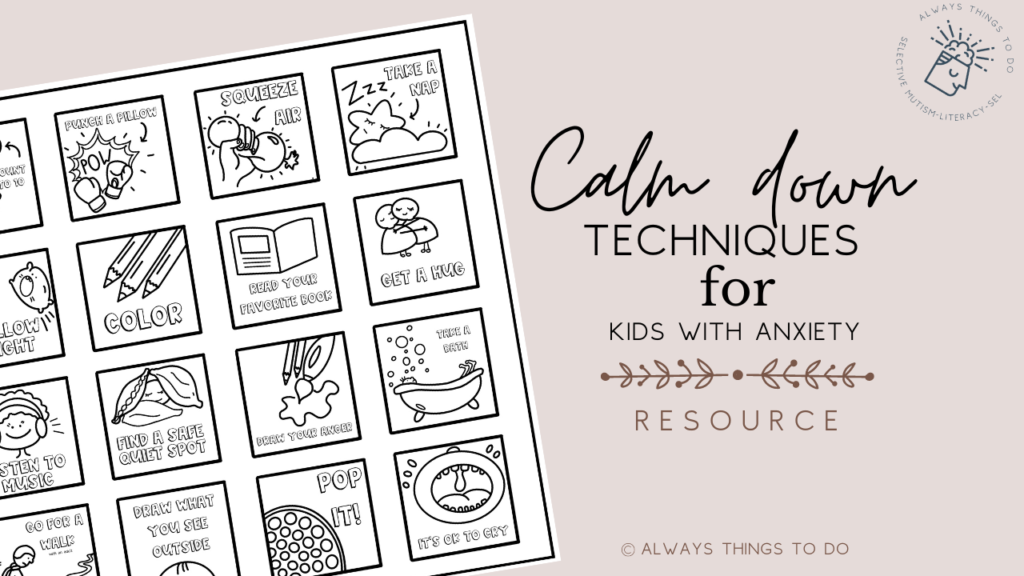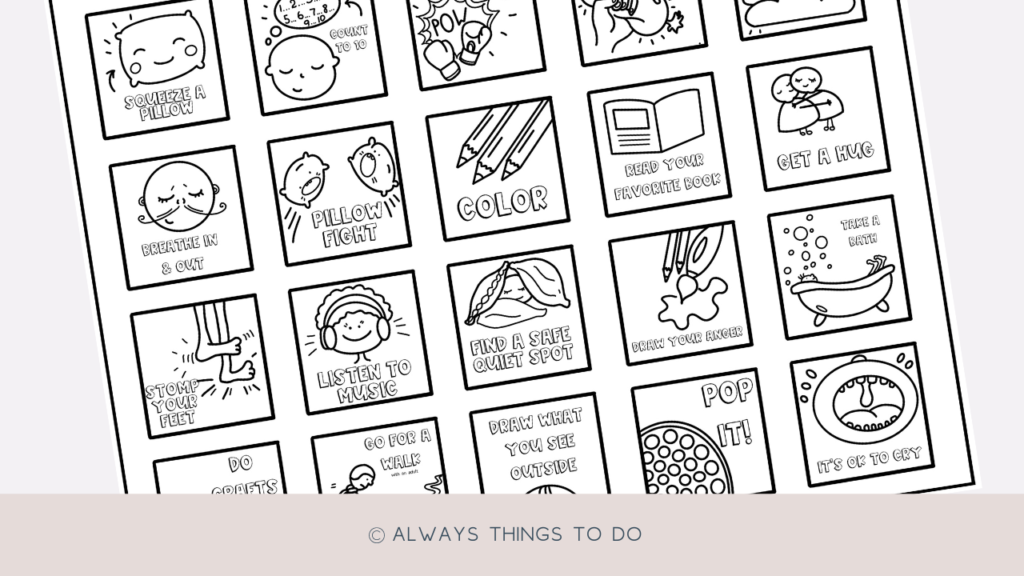How to Calm Down From Anger or Other Big Emotions: Emotion Regulation for Kiddos with Anxiety (7–8-year-olds).

My daughter has anxiety. While we have been on a journey of overcoming selective mutism (which is rooted in anxiety), I learned about and experimented with many calm down from anger techniques. Before I even started to understand how essential it was for my child to learn to calm down from anger, the house was like a battlefield, day after day. Her being very young, some sensory issues, academic struggles were fueling my child’s emotional rollercoaster.
At school, where she was mute, my daughter would hold it together, and all the anger, frustration, and emotional aftermath from the inability to speak and socialize like other kids would trigger explosion of emotions during pick up time and at home.
Screaming, hitting, crying was accompanying our evenings and made me feel like I was failing at everything.
I shared some great calm down from anger techniques for smaller kids and the causes of tantrums for children with selective mutism anxiety in my post about “Selective Mutism Tantrums: How to Deal With a Ball of Anger After School.” Go ahead and read it to learn about triggers for children with selective mutism.
In this post I will talk about calm down techniques for a bit older kid (7-8 year old kiddos), but some of the ideas may as well be appropriate for younger worriers.
So going back to meltdowns and mood swings, the key idea in tackling meltdowns and mood swings is to, of course, learn to predict them. Certain situations, hunger, tiredness, sensory triggers, or the roller coaster of socializing and making friends for a child with anxiety may all contribute to those moments when a child with anxiety cannot hold it together anymore.
The second important key to tackling meltdowns and angry moments is to allow it to happen without putting the blame on or shaming a child. Acceptance of emotions is essential to showing a child that the angry behavior is just the expression of emotions, and that is it normal and manageable.
The third key element in dealing with child’s anger and emotional outbursts is to continuously teach them to verbalize what they feel. Frustration from inability to name the feeling and the reasons for it may fuel the anger and keep your child from being able to regulate when they grow a bit older.
When my daughter was 4-5 years old and her emotional meltdowns were bad I started with the idea of verbalizing emotions for her and explaining the causes of meltdowns.
“I look angry now. It’s OK to be angry. You feel hungry and your body needs some rest.”
“You seem frustrated by the situation. It’s OK to be frustrated. Let’s help your body feel better. Do you want to watch a cartoon with me or lay in bed with you bunny?”
“You look very upset. It’s OK to feel that way. I feel upset, too, sometimes. How can I make you feel a bit better? Do you want to color with me or read a book?”
Phrases like this would be repeated over me over and over for two or more years until, happily for us, she was mature enough, to start labeling her own emotions and trying to give reasons behind her frustration.
Even now that my daughter is 8, sad moments and anger happens. But the huge difference is that she knows that:
- big emotions like anger or sadness are OK and normal,
- she will be given personal time to feel her emotions,
- she will not be punished for screaming or being angry,
- I will talk to her about what happened and why she feels that way,
- she will explain what she feels and why,
- she will choose her own way to tackle big emotions.
In a nutshell, teaching a child to approach big emotions starts with lessons on how to verbalize what they feel and find ways to calm themselves down.
This should take some time to happen, but it will pay off in the long run. If you start yearly, by the age of 6-7 your child will be able to explain the causes of their anger or other emotions and be more independent in choosing healthy ways to calm down.
These are 20 ways to calm down from anger or other big emotions: a cheat sheet for emotion regulation.

This chart was created for my daughter and with her support. It shows 20 ways to calm down from anger for a kiddo with anxiety.
I consider my daughter a little expert in these calm down techniques. Over three years of learning about feelings and emotion regulations at school and at home since she was 5, she pretty much has it under her belt. We also tried all of them and many more. The best ones were selected for this fun chart.
So, here are creative ways to calm down from anger or any big emotion for a kiddo with anxiety:
- Squeeze a pillow
- Count to 10
- Punch a pillow
- Squeeze air
- Take a nap
- Breathe in and out
- Pillow fight
- Coloring
- Read a book
- Get a hug
- Stomp your feet
- Listen to music
- Find a safe quiet spot
- Draw your anger
- Take a bath
- Do crafts
- Go for a walk
- Draw what you see outside
- Pop it!
- It’s OK to cry
Before your child can use these calm down from anger techniques, model how to do to for your child and do it with your child.
You can pick and choose and try it with your child. Some calm down techniques will become your child’s favorite. Just experiment.
Squeezing a pillow is a great way to tackle anger and a desire to hit for a younger child. It still works for my 8-year-old, by the way, in time of her biggest frustration moments.
Counting till ten will probably be taught to your child by your teacher. It’s so easy, and it works.
Punching a pillow is very similar to squeezing a pillow. It surely can start with anger, but it will turn into something fun like a pillow fight. I can assure you!
Squeezing air is simple and effective, too. Pretend you have big bubbles of air in both hands. On 1-2-3 squeeze the air hard. Repeat it over and over until your kiddo drops down with no energy. Just kidding.
Taking a nap or just lying down quietly with some relaxing noise or sound always works for my selective mutism anxiety child.
Breathing in and out is a good old trick. It works fast.
Pillow fight is another way to turn anger into happy smiles. It help your child to release energy in a safe way.
Coloring or reading a book may work for some kiddos. My advice, have some new book and new coloring page ready to go in moments when you need them. Buy them before and stash them until the right moment. The novelty of the book or a coloring page will do the trick of shifting attention to something creative.
Getting a hug might be the key. In the end, even in moment of big emotions, screaming and hitting, children want to be hugged and accepted. It works all the time.
Stomping feet has a similar force as punching a pillow and a pillow fight. Try it. It works.
Listening to music should work for some kiddos if they are music lovers. Try and experiment.
A safe and quiet spot is a must for any child with anxiety. It’s sort of a must to have. It can be a corner in the bedroom, a self-built mini fort, under-the-bed hide out, or any other favorite place. Have a blanket, a toy, some small crafts favorite fidgets ready for this spot.
Drawing anger will work for kiddos who love crayons. In fact, drawing emotions has been recognized by psychologists as a great technique of “verbalizing” emotions.
Taking a bath works because the magic of the bath is in taking kids’ energy away and turning them sleepy. Ha-ha. After a bath my daughter usually feels sleepy and ready to finish the day. My favorite!
Crafting is another great idea! Having a stash of craft tools is a great way to be prepared for any moods or your child boredom.
Going for a walk and being in the nature is the best way to relax! There is something about a walk in the park or roaming through the forest that makes kids calm! Try it!
Drawing what they see outside is the best way to distract them from what’s happening inside. Just sitting by the window and observing what’s happening outside can be a great calm down technique. Sit next to your child, start talking about what’s happening outside of the window. Make it fun. Create a story. Giggle.
Pop its! Pop its! They work!
Finally, it’s OK just to cry it out. Be there for them!
Make sure to download the techniques and follow these instruction to print them as a poster:
- Open in Adobe Acrobat
- Choose “poster” option
- Change tile scale to 150%
- Cut extra edges to glue the 4 pieces together
If you like this post about how to calm down from anger for a child, you may find other post educational and helpful. My recommendations on the topic are:
- Helping a Child With Selective Mutism Through Big Emotions: Mom/Parent-Child Relationship, Resentment, Anger, and Detachment.
- Selective Mutism Tantrums: How to Deal With a Ball of Anger After School.
Other recommendations:
- 7 Must-Do Things For A Parent of A Child With Selective Mutism: Actionable Tips and Resources to Consider.
- 6 Things You Can Do Right Now To Help Your Child With Selective Mutism.
- “What Is Selective Mutism?”
- “Selective Mutism: How To Beat Crisis, Screaming, and Fear.”
- Diagnosis of Selective Mutism: Simple Parent Guide and Steps to Take.
- What Are The Causes of Selective Mutism?
- Is Selective Mutism a Disability?
- How Do You Treat Selective Mutism?
- 70 Selective Mutsim Symptoms & 3 Diagnostic Criteria.
- Selective Mutism Myths: Most Common Concerns Addressed.
- Selective Mutism Classroom Accommodations: What You Need To Know About 504 and IEP.
Check out the expanding library of tools. Go to the selective mutism page and scroll to the bottom section, “Latest Projects.”
Connect with me on social media @alwaysthingstodo.



